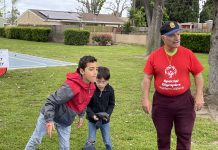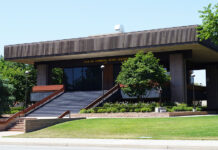A Los Alamitos dentist has been recognized by more than 8,000 dentists around the world after developing a treatment for successful alignment that most dentists apparently thought would not have been possible. Dr. Barry Israel, DDS was recognized at the recent Invisalign Summit in Las Vegas, NV for a successful treatment case he submitted for the Invisalign GP Summit Shootout. His treatment case was voted as a best-in-class example by his fellow doctors of the successful patient results that can be achieved with Invisalign.
Having now practiced general dentistry in Los Al for more than two decades, Israel said this week he was “thrilled” to learn that he his case was selected, but at once taken was aback to learn he would have to present the case in person on stage before 1,600 fellow dentists.
And while it was “a tremendous honor to be recognized by his peers”, Israel said the honor was somewhat bittersweet. Israel said he only decided to prepare the massive amount of paperwork to enter the Shootout following the death of his of his younger sister Marni.
“In a way, entering the Shootout was therapy for me,” he said, noting the hours and hours it took to retrace and document the case that he pursued only following her loss.
The Invisalign Summit is Align Technology’s premier clinical education conference. Doctors from around the world share their treatment experiences, learn clinical techniques and best practices from Invisalign experts, and review new treatment tools and educational resources.
A highlight of the conference is the culmination of the Invisalign GP (General Practitioner) Summit Shootout, a months-long competition where doctors throughout the United States and Canada demonstrate their successful use of Invisalign to treat patients with especially complex conditions. That competition was this year won by the Los Alamitos dentist.
More than 170 treatment cases were submitted in four categories, including Crowding, Spacing, Interdisciplinary, and Bonus. The treatment cases were evaluated prior to going through a double-blind voting process.
General practice doctors throughout North America voted on each treatment case based on before and after photos. Special consideration was given to the difficulty of the treatment and the results achieved. Over 8,000 votes were cast on the 100 top scoring treatment cases.
Israel’s treatment case received the highest score in the Interdisciplinary category.
While challenges in dentistry still exist, make no mistake. Israel loves his work; even more since the digital revolution has inspired technologies like the iTero Element and Invisalign. “It’s hard to believe how much the digital revolution has exploded in dentistry,” said Israel this week.
While the actual process has not changed, the tools now available to dentists have been revolutionized by digital technology.
Long gone are the clay models as dentists, now use hand held scanners to create 3-D renditions of a patient’s gums and mouth. Israel says “it is really fun” as he explains the computer animation on a screen that depicts the movement, over time, of his patients teeth. The Invisalign retainers slowly nudge teeth into new positions to create better alignment and thus, an improved smile for the patient.
According to a statement from Align technology, “we revolutionized the orthodontic industry with the introduction of the Invisalign system, and we have never lost sight of that spirit of innovation.”
“Our teams are constantly pushing the boundaries of what’s possible—from 3D printing technology to new aligner materials and new software algorithms that determine the optimal way to move teeth digitally with one goal in mind,” said the statement.
Israel, like hundreds of thousands of dentists and orthodontists around the world, have fully embraced the new technology. Here is how it works:
After a dentist scans a patient’s mouth, they use the digital technologies, including x-rays, to determine the amount of pressure required to move teeth around inside the mouth to achieve a better smile.
Using the Align Technology program, dentists use computer-based algorithms, combined with their dental knowledge, to create a successful treatment plan that projects the amount of time it will take for a series of clear, medical grade plastic retainers worn by the patient to slowly align their teeth.
Israel said dentists then submit the program to international professionals who literally create a 360 degree, 3-D model to demonstrate what the dentist has ordered in their treatment plans before sending it back. The 3-D rendition illustrates the movement of the teeth, weekamd animates, week-by-week, the prescribed program as dentists make final changes before sending it back for the retainers to be made.
“Dentistry is an art and a science,” he said.
In every human mouth, he says, the bottom teeth are almost always shaped by the upper layer of the mouth. The “upper arch is the criminal and the lower arch is the victim,” said Israel.
“The case I submitted and won was an extreme case, yet the patient was extremely motivated.”
Given the extreme situation in her mouth, Israel said most experts would have thought the Invisalign process would not work.
In today’s dental world, the old standard, metal braces, are only used in the most extreme cases. “She told me I don’t want to have metal braces,” so Israel designed the program that ultimately was honored by his peers. It was such an “extreme” case, dentists would have not thought the teeth could have been straightened by Invisalign retainers alone, he said.
Israel said he noticed that her wisdom teeth were “impacted,” meaning they were still below the gum on the bone of her jaw. “They had never erupted,” he said, so he thought by surgically extracting them, there might be room for the remaining teeth to be moved.
Over time, his treatment was successful and when the peer review by thousands of dentists acknowledged Israel’s work, he was invited to present the case to more than 1,600 fellow dentists.
Immediately, he called a friend of his to help him prepare for his new role as a public speaker. While the opportunity was gratifying, he said, it was also terrifying to stand before a packed auditorium of peers as he recently presented the case in Las Vegas.
“Thankfully, after the first slide, all the butterflies went away.”
To ensure he delivers the best results for his patients, Israel said he continually leverages improvements in oral healthcare technologies, materials, and techniques. Additionally, he is a partner in the San Antonio Orthodontic Study Group, which provides ongoing education for dentists.
He earned a Bachelor of Science in Biological Sciences from the University of Southern California and a Doctorate of Dental Surgery from the University of Southern California Dental School. He was also a faculty member at the USC Dental School for six years, instructing students in the dental clinic as they treated patients.
Israel is an active member of the American Dental Association, the California Dental Association, the Harbor Dental Association, as well as the International Association for Orthodontics.
“I love improving my patients lives by improving their smiles”, he said. “It was a tremendous honor to have one of those smiles judged by my fellow doctors as a best-in-class example of just what can be achieved,” said Israel.
“It was an absolute thrill to present my treatment case to them, live and in person, and to learn firsthand from the other category winners how I can help my patients’ smile even more.”












